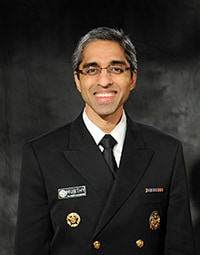Surgeons Generals Statements on Community Water Fluoridation
Since the 1950s, U.S. Public Health Service Surgeons General have committed his or her support for community water fluoridation. Below are endorsements supporting community water fluoridation from various Surgeons General:
2016 Surgeon General’s Statement on Community Water Fluoridation

Over the past 70 years, community water fluoridation has contributed to dramatic declines in both the prevalence and severity of tooth decay, leading the Centers for Disease Control and Prevention to name it as one of 10 great public health achievements of the 20th century, alongside immunizations, family planning, tobacco control, and motor vehicle safety.
Water fluoridation is the best method for delivering fluoride to all members of the community, regardless of age, education, income level or access to routine dental care. Fluoride’s effectiveness in preventing tooth decay extends throughout one’s life, resulting in fewer – and less severe – cavities. In fact, each generation born over the past 70 years has enjoyed better dental health than the one before it. That’s the very essence of the American promise.
Our progress on this issue over the past 70 years has been undeniable.
But we still have work to do. Because we know that so much of our health is determined by zip code rather than genetic code. That’s why creating a culture of disease prevention through community efforts – and ensuring health equity for all – is one of my highest priorities.
Community water fluoridation helps us meet these goals; as it is one of the most cost-effective, equitable, and safe measures communities can take to prevent tooth decay and improve oral health.
Advocates and community leaders have fought to make water fluoridation a reality in communities throughout our country.
Today, we applaud their efforts. But our work is far from finished, and we will not rest until every community is equipped with the many tools they need to help their residents live healthy, happy lives.
Vivek H. Murthy, M.D., M.B.A.
United States Surgeon General
This statement is also available as a PDF file [PDF– 166Kpdf icon].
2013 Surgeon General’s Statement on Community Water Fluoridation

Dear Conference Attendees:
Welcome to the 2013 National Oral Health Conference. I want to thank you for the leadership and efforts you are providing to the nation in the area of oral health.
As Surgeon General I have been working hard to encourage individuals and communities to make healthy choices because I believe it is better to prevent illness and disease rather than treat it after it occurs. Community water fluoridation is one of the most effective choices communities can make to prevent health problems while actually improving the oral health of their citizens.
One of water fluoridation’s biggest advantages is that it benefits all residents of a community—at home, work, school, or play—through the simple act of drinking fluoridated water. Where water fluoridation is a community-wide intervention, the benefits are not limited by a person’s income level or their ability to receive routine dental care. It also is a very cost-effective intervention. A lifetime of cavity prevention can be obtained for less than the cost of one dental filling.
Fluoridation’s effectiveness in preventing tooth decay is not limited to children, but extends throughout life, resulting in fewer and less severe cavities. In fact, each generation born since the implementation of water fluoridation has enjoyed better dental health than the generation that preceded it.
As then-Surgeon General David Satcher noted in Oral Health in America: A Report of the Surgeon General (May 2000), community water fluoridation continues to be the most cost-effective and practical way to provide protection from tooth decay in a community. The U.S. Centers for Disease Control and Prevention has recognized fluoridation as one of 10 great public health achievements of the 20th Century.
This year marks the 68th anniversary of community water fluoridation.
I join with previous Surgeons General in acknowledging community water fluoridation as an effective public health strategy, and recommend its continued use and expansion to enhance the oral health of all Americans.
Regina M. Benjamin, MD, MBA
VADM U.S. Public
United States Surgeon General
2004 Surgeon General’s Statement on Community Water Fluoridation

As noted in Oral Health in America: A Report of the Surgeon General, community water fluoridation continues to be the most cost-effective, equitable and safe means to provide protection from tooth decay in a community. Scientific studies have found that people living in communities with fluoridated water have fewer cavities than those living where the water is not fluoridated. For more than 50 years, small amounts of fluoride have been added to drinking water supplies in the United States where naturally-occurring fluoride levels are too low to protect teeth from decay. Over 8,000 communities are currently adjusting the fluoride in their community’s water to a level that can protect the oral health of their citizens.
Over 170 million people, or 67 percent of the United States population served by public water supplies, drink water with optimal fluoride levels for preventing decay. Of the 50 largest cities in the country, 43 are fluoridated. Although water fluoridation reaches some residents in every state, unfortunately, only 24 states are providing these benefits to 75 percent or more of their residents.
A significant advantage of water fluoridation is that all residents of a community can enjoy its protective benefit—at home, work, school, or play—simply by drinking fluoridated water or beverages and foods prepared with it. A person’s income level or ability to receive routine dental care is not a barrier to receiving fluoridation’s health benefits. Water fluoridation is a powerful strategy in our efforts to eliminate differences in health among people and is consistent with my emphasis on the importance of prevention.
The U.S. Centers for Disease Control and Prevention has recognized the fluoridation of drinking water as one of ten great public health achievements of the twentieth century. Water fluoridation has helped improve the quality of life in the United States by reducing pain and suffering related to tooth decay, time lost from school and work, and money spent to restore, remove, or replace decayed teeth. An economic analysis has determined that in most communities, every $1 invested in fluoridation saves $38 or more in treatment costs. Fluoridation is the single most effective public health measure to prevent tooth decay and improve oral health over a lifetime, for both children and adults.
While we can be pleased with what has already been accomplished, it is clear that there is much yet to be done. Policymakers, community leaders, private industry, health professionals, the media, and the public should affirm that oral health is essential to general health and well being and take action to make ourselves, our families, and our communities healthier. I join previous Surgeons General in acknowledging the continuing public health role for community water fluoridation in enhancing the oral health of all Americans.
Richard H. Carmona, M.D., M.P.H., F.A.C.S.
VADM, USPHS
United States Surgeon General
This statement is also available as a PDF file pdf icon[PDF– 399K].
2001 Surgeon General’s Statement on Community Water Fluoridation

December 3, 2001—For more than half a century, community water fluoridation has been the cornerstone of caries prevention in the United States. As noted in my May 2000 report, Oral Health in America: A Report of the Surgeon Generalexternal icon, community water fluoridation continues to be the most cost-effective, practical and safe means for reducing and controlling the occurrence of tooth decay in a community. In thousands of communities in the United States where naturally-occurring fluoride levels are deficient, small amounts of fluoride have been added to drinking water supplies with dramatic results. More than 50 years of scientific research has found that people living in communities with fluoridated water have healthier teeth and fewer cavities than those living where the water is not fluoridated.
Almost two-thirds of the United States population served by public water supplies consume water with optimal fluoride levels. Of the 50 largest cities in the country, 43 are fluoridated. A significant advantage of water fluoridation is that anyone, regardless of socioeconomic level, can enjoy these health benefits during their daily lives—at home, work, or at school or play—simply by drinking fluoridated water or beverages prepared with fluoridated water. Water fluoridation is a powerful strategy in our efforts to eliminate health disparities among populations. Unfortunately, over one-third of the United States population (100 million people) is without this critical public health measure.
The U.S. Centers for Disease Control and Prevention has recognized the fluoridation of drinking water as one of ten great public health achievements of the twentieth century. Water fluoridation has helped improve the quality of life in the United States through reduced pain and suffering related to tooth decay, reduced time lost from school and work, and less money spent to restore, remove, or replace decayed teeth. Fluoridation is the single most effective public health measure to prevent tooth decay and improve oral health over a lifetime, for both children and adults.
Water fluoridation continues to be a highly cost-effective strategy, even in areas where the overall caries level has declined and the cost of implementing water fluoridation has increased. Compared to the cost of restorative treatment, water fluoridation actually provides cost savings, a rare characteristic for community-based disease prevention strategies.
While we can be pleased with what has already been accomplished, it is clear that there is much yet to be done. I join previous Surgeons General in acknowledging the continuing public health role for community water fluoridation in enhancing the oral health of all Americans.
David Satcher, MD, PhD
United States Surgeon General
This statement is also available as a PDF file pdf icon[PDF– 399K].
1995 Surgeon General’s Statement on Community Water Fluoridation

December 14, 1995—Nineteen ninety-five marked the 50th anniversary of the initiation of community water fluoridation in the United States. Data consistently have indicated that water fluoridation is the most cost-effective, practical, and safe means for reducing the occurrence of tooth decay in a community. Water fluoridation continues to be the cornerstone of community oral disease prevention. The benefits of fluoridation are available, on average, for little more than $0.50 per person per year, and even less, in large communities. Today, 62 percent of the population served by public water supplies have access to adequate levels of fluoride in their drinking water. It has been demonstrated that the action of fluoride in preventing tooth decay provides a benefit to children and adults throughout their lives. The health benefits of fluoridation include a reduction in the frequency and severity of dental decay, a decrease in the need for tooth extractions and fillings, a reduction in pain and suffering associated with tooth decay, and the obvious elevation of self-esteem that goes with improved functioning and appearance.
As we look ahead to the next century, we can be thankful for the progress that has been made in improving the nation’s oral health, but we can not be complacent. Although the ravages of dental decay have decreased in recent years, there still remains a large segment of the population afflicted by this disease. Ongoing efforts to reduce the burden of dental decay in our population are required, particularly for those groups demonstrated to be at higher risk of dental decay or with inadequate access to professional dental care. Continuing attention to assuring the quality of fluoridation activities by water suppliers and state and local health authorities is essential. Ultimately, optimizing the public’s oral health through community water fluoridation will require a concerted effort by public officials, health professionals, and the public.
Audrey F. Manley, MD, MPH
Acting United States Surgeon General